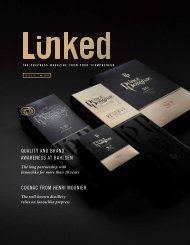Janoschka magazine Linked_V6_2021
You also want an ePaper? Increase the reach of your titles
YUMPU automatically turns print PDFs into web optimized ePapers that Google loves.
62 t o t e l l t h e t r u t h
issue #6 ©
l i n k e d
63
We didn’t start the fire
– or did we?
So was it really these little wooden sticks with
their chemical-coated heads and a friction surface
that transformed the previously laborious
business of lighting a fire into a “free-handed”
experiment that turned the task into child’s
play? Hardly. But exactly when did these handier
and simpler utensils replace the lengthy
process of drilling, striking or ploughing to
make a fire? And what did they look like?
However, with the invention of the wheel lock
in the late fifteenth century, things began to
change in the traditional fire-making culture.
Originally developed for rifles, a drawstring (or
a spring) would set a little iron wheel in motion
that then applied pressure to a piece of pyrite
(iron sulphide). If the sparks it generated came
into contact with gunpowder, it would explode;
if they landed on tinder, it would ignite.
For 40,000 years, fire-striking was the usual
method. Until well into the nineteenth century,
a fire-steel, flints (firestones) and tinder were
the valuable utensils one needed to light a fire.
Around one hundred years later, the key idea
for developing a flintlock lighter emerged –
once again from the gunmakers’ workshops.
A cock holding a flint struck against steel: the
result was sparks… tinder… fire.
Leonardo da Vinci – drawing and
description of a matchlock for a scoppietto
(Codex Madrid)
Flint locks as lighters









